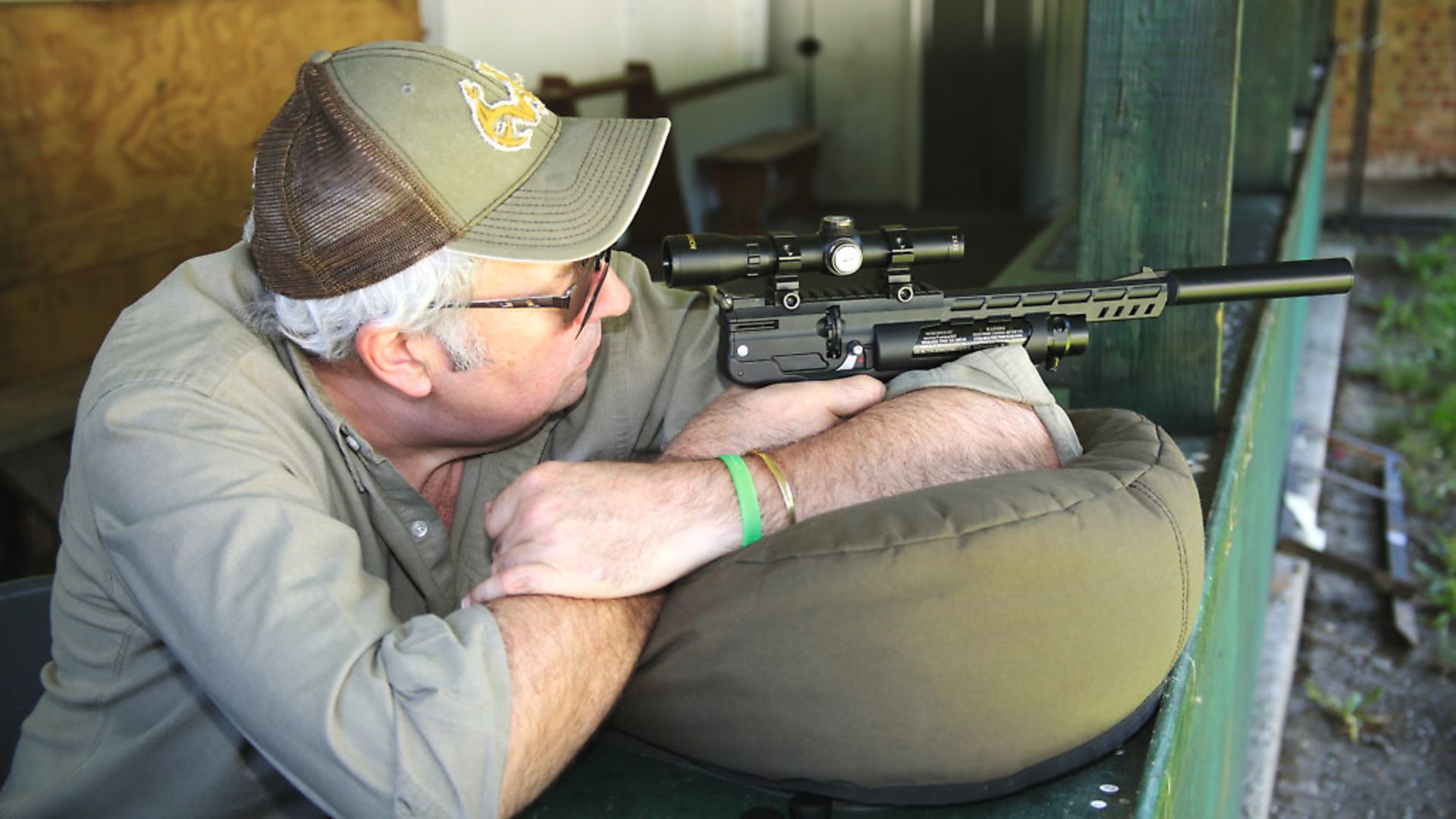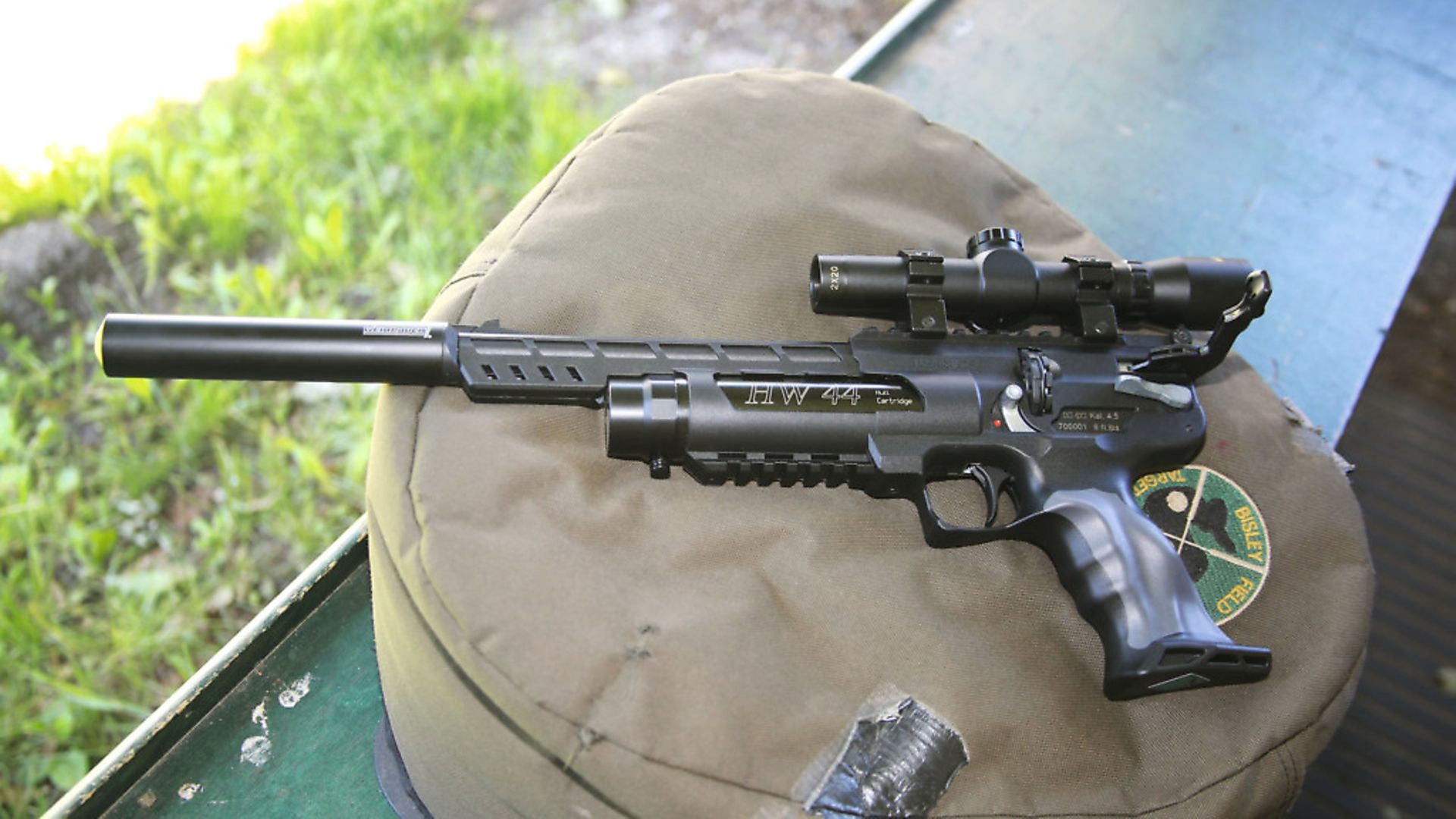The editor sets out to develop new shooting skills – via an exclusive test of the brand new Weihrauch HW44 pre-charged pneumatic pistol
 credit: Archant
credit: Archant
I’ll begin this test of Weihrauch’s brand-new HW44 pre-charged pistol with a confession; I’ve always done my best to avoid shooting pistols, because they’re incredibly demanding and I’m rubbish at it. I accept this isn’t the best way to establish my credentials for testing this extremely significant airgun and Weihrauch’s very first production PCP pistol. Yet, I believe I’m the man for this job and as this test unfolds, I hope you’ll agree.
As I write, I’m fresh in from my club at Bisley and 150 shots’ worth of introduction to the HW44, to add to the many thousands of reassuringly familiar ones I’ve put through the HW110 rifle, on which the test pistol is based. I’m buzzing with what I’ve experienced and achieved in a single afternoon, and I’ll be out at first light tomorrow to get some more of it. Meanwhile, here’s what’s at the centre of what is already becoming a new phase in my shooting life.
Notes from headquarters
This pistol is such a major move for Weihrauch that the company invited a party of the UK’s airgun journalists over to its factory in Mellrichstadt, Germany, to see how the HW44 is made. I’ve been to Weihrauch headquarters a few times but the latest, fully modernised version is firmly on the impressive side of breathtaking. You’ll see what we saw during our tour on page 66, but for now, let’s focus on the HW44.
The HW44
Anyone who is remotely familiar with the Weihrauch HW110 rifle will see instantly where the ’44 comes from. It’s the same practical mix of a 10-shot, side-lever action, allied to a frugal, pre-charged pneumatic powerplant, a precise, two-stage adjustable trigger and one of Weihrauch’s own, match-grade barrels. There’s also the signature use of ballistic polymer throughout the pistol’s action block, reservoir and barrel shrouds, and the grip.
The use of polymer, especially by a company deemed the custodians of traditional and ‘solid’ engineering, caused many a raised eyebrow when the HW110 was revealed in 2015. That rifle has become a massive success, mainly, I believe, because of how it performs for the asking price of £680, or near offer. This brings me smack-bang into what will inevitably be one of the new pistol’s major features – its price.
 credit: Archant
credit: Archant
How much!
The Weihrauch HW44 will retail at £620, just 60 quid short of the price of the HW110 rifle. The obvious question is, ‘but how can this be?’ Having seen the HW44 and 110 through their production phases from start to finish, I’m the very fellow to answer that.
The simple fact of airgun production life is, the HW44 costs just a few euros less to make than its HW110 stablemate. That’s the deal. Apart from saving a bit of tube stock and a handful of ballistic polymer compound, the HW44 contains everything that made the 110 a best-seller. In fact, making an airgun that shoots to the standard of the HW110, only smaller, with a totally reconfigured trigger system and a range of internal ‘adaptations’ that the enigmatic company MD, Hans Weihrauch, politely declined to explain in detail, can actually be more expensive. Now factor in the lower expected sales numbers over which to spread the cost of production, and that £60 price difference soon makes financial sense. We may not like the seemingly eye-watering price of high-performance airgunning, but a pistol like this costs what it costs for a reason. Now let’s look at that performance in action.
Ready to shoot
Getting the HW44 in shooting trim involves the identical process used by the HW110. The same probe charger is the conduit for 200 bar’s worth of compression, and that familiar, removable, rotary, 10-shot magazine, .177 calibre on the test pistol, takes care of shuttling pellets to the breech with each back-forth cycle of the sidelever. That’s it really, unless you wish to attach the optional silencer, which locates cut-outs and pin ports in the HW44’s muzzle, before being secured by a pair of hex-headed grubscrews. Air installed, pellets loaded, magazine fitted, and one of Weihrauch’s own 2 x 20 pistol scopes clamped to the pistol’s Picatinny mounting rail – let’s shoot the HW44.
Impressive output
Each of those 200 bar charges produces over 100 shots at 5.2ft.lbs. in .177, and around 120 in .22. That’s impressive stuff right from the off. Again, like the HW110 rifle, the 44 runs Weihrauch’s ‘regulated valve system’, which causes all manner of tragic debate among airgunners around the ‘is it a regulator, or not?’ question. I was told by Hans Weihrauch at the launch of the HW110 that ‘its output is regulated’. He then told me that the HW110 ‘didn’t have a regulator as such’. I soon gave up trying to analyse the difference between ‘regulated output’ and ‘having a regulator’, and concentrated on shooting, which is exactly what I’ve done here.
Proper pistol people
The first thing I did was hand the HW44 over to my clubmate, Rob, who really can shoot a pistol. Rob’s all about the one-handed, match-style, paper-target shooting, with the funny spectacles and the perfectly practised shooting routine, so the first thing he did was to take off the scope I’d just fitted. I was concerned that a mere 2x wouldn’t be enough magnification to pinpoint my targets, and here was a proper pistol shooter doing away with all optical assistance and going with open sights.
Rob took his measured time and shot a card at 10 metres. He seemed pleased with those first 10 shots and paid compliments to the HW44’s trigger. ‘That, is a nice pistol, and that trigger is extremely good.’ Rob usually shoots a fully tricked-out Walther match pistol, so any sort of praise from him is significant. He remarked that the HW44 felt slightly front-heavy, compared to what he’s used to, and the Weihrauch’s stainless-steel air reservoir would explain that. Overall, Rob was impressed and frequently said so.
Phill has a go
Our Technical Editor, Phill Price, can really shoot a pistol and he’ll be testing the HW44 for his own magazine, Air Gunner, in the near future, so he grabbed the chance for a short session with it whilst I messed about setting up a beanbag and chair for my low-skill benchrest approach. Phill went for his preferred two-handed stance and I could hear pellet after pellet connecting with targets at ranges out to 20 yards. Phill’s nod of approval was easy enough to interpret. He, too, praised the pistol’s trigger and remarked, ‘that thing really shoots’, as he handed the HW44 back to me. No pressure there, then.
Trigger and consistency
I refitted the pistol scope and set up the chrono’ for my initial test session, making note of the numbers and getting a feel for the HW44’s two-stage trigger.
The pistol on test varied by 14 f.p.s. from its second shot to its 50th, and yes, that trigger is a sweet and positive thing, even in its non-adjusted, factory supplied state. I’ll do the full-to-empty chrono’ test in time for next month’s follow-up report, but for the rest of this one I’d like to concentrate on accuracy.
Potential V realised performance
Shot from a clamp at Weihrauch headquarters, the HW44 prints sub-20mm diameter groups at 25 metres. That didn’t surprise me at all, because I can shoot groups tighter than that with an HW110 rifle, which runs virtually identical performance components. In the real world, such small groups with a pistol are never going to be consistently produced by a shooter using conventional stances, so the real trick, as it is with high-grade rifles, is to help the user to get closer to the potential accuracy of the gun. With a rifle and a pistol, this depends largely on ergonomics.
The HW44’s grip
The ambidextrous grip of the HW44 is a remarkable thing. It’s not a super-custom, sculpted match handle by any means, yet it seems to fit a wide variety of hand sizes. I’m not entirely sure how this happens but I’ve seen shooters from extreme ends of the dimension scale handling this pistol, and they’re all comfortable with it.
Of course, burying the HW44 in a beanbag and resting the whole ensemble on a bench pretty much negates the tremendous amount of input Weihrauch invested in that grip, but this initial test is to acquaint me with the pistol’s way of doing things and for me to learn just what it can do if I can push it anywhere near its limit.
My impressions
With my ‘low talent’ set-up, I was hitting 45mm diameter spinners out to 20 yards, and 30mm examples at 15 yards, with pleasing regularity. Then I got up from the bench, took the HW44 in both hands, and began to shoot it properly. Yes, of course the distant spinners were out of the question now, but I was still connecting with targets fairly consistently, and relaxing into the stance with every shot. I really think I can do this, at least to a standard that can be worked on rather than abandoned. You know what? I’m definitely starting to like this pistol-shooting lark and I want to do more of it. Please tune in next month, when we’ll find out more about the Weihrauch HW44 – and whether I’ll ever make a pistol shooter.
Specification
Model: HW44
Manufacturer: Weihrauch
Country of origin: Germany
Price: £620 inc. 2 x 10-shot mags
Type: Pre-charged, multi-shot, pistol
Calibre: .22, .177, .25
Cocking/loading: Side-lever
Loading: Via removable, rotary 10-shot magazine
Trigger: 2-stage, adjustable
Grip type: Ambidextrous synthetic
Weight: 1.6k (3.5lbs) Inc scope and mounts
Length: 330mm (13ins)
Barrel: 254mm (10ins)
Fill pressure: Max 200 bar
Shots per charge: 110 in .22, 100 in .177
Variation over 50 shots: 14 fps for .177 on test
Average energy: 5.2 ft.lbs.
Options: Silencer. Price TBA
Contact: www.hullcartridge.co.uk